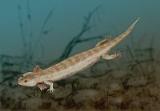
Microbrachis
Encyclopedia
Microbrachis is an extinct genus of lepospondyl
amphibian
from the Carboniferous
period of what is now the Czech Republic
.
Microbrachis was an elongated, salamander
-like creature, about 15 centimetres (5.9 in) long, with over 40 vertebrae instead of the average 15-26 in its living relatives. It had minute limbs, and probably swam using fish
-like lateral body movements. Microbrachis probably fed on fresh water plankton
such as shrimp
. Microbrachis was pedomorphic, retaining its larva
l gill
s in adulthood. Similar traits are found in the extant axolotl
.
Lepospondyli
Lepospondyli are a group of small but diverse Carboniferous to early Permian tetrapods. Six different groups are known, the Acherontiscidae, Adelospondyli, Aïstopoda, Lysorophia, Microsauria and Nectridea, and between them they include newt-like, eel- or snake-like, and lizard-like forms, along...
amphibian
Amphibian
Amphibians , are a class of vertebrate animals including animals such as toads, frogs, caecilians, and salamanders. They are characterized as non-amniote ectothermic tetrapods...
from the Carboniferous
Carboniferous
The Carboniferous is a geologic period and system that extends from the end of the Devonian Period, about 359.2 ± 2.5 Mya , to the beginning of the Permian Period, about 299.0 ± 0.8 Mya . The name is derived from the Latin word for coal, carbo. Carboniferous means "coal-bearing"...
period of what is now the Czech Republic
Czech Republic
The Czech Republic is a landlocked country in Central Europe. The country is bordered by Poland to the northeast, Slovakia to the east, Austria to the south, and Germany to the west and northwest....
.
Microbrachis was an elongated, salamander
Salamander
Salamander is a common name of approximately 500 species of amphibians. They are typically characterized by a superficially lizard-like appearance, with their slender bodies, short noses, and long tails. All known fossils and extinct species fall under the order Caudata, while sometimes the extant...
-like creature, about 15 centimetres (5.9 in) long, with over 40 vertebrae instead of the average 15-26 in its living relatives. It had minute limbs, and probably swam using fish
Fish
Fish are a paraphyletic group of organisms that consist of all gill-bearing aquatic vertebrate animals that lack limbs with digits. Included in this definition are the living hagfish, lampreys, and cartilaginous and bony fish, as well as various extinct related groups...
-like lateral body movements. Microbrachis probably fed on fresh water plankton
Plankton
Plankton are any drifting organisms that inhabit the pelagic zone of oceans, seas, or bodies of fresh water. That is, plankton are defined by their ecological niche rather than phylogenetic or taxonomic classification...
such as shrimp
Shrimp
Shrimp are swimming, decapod crustaceans classified in the infraorder Caridea, found widely around the world in both fresh and salt water. Adult shrimp are filter feeding benthic animals living close to the bottom. They can live in schools and can swim rapidly backwards. Shrimp are an important...
. Microbrachis was pedomorphic, retaining its larva
Larva
A larva is a distinct juvenile form many animals undergo before metamorphosis into adults. Animals with indirect development such as insects, amphibians, or cnidarians typically have a larval phase of their life cycle...
l gill
Gill
A gill is a respiratory organ found in many aquatic organisms that extracts dissolved oxygen from water, afterward excreting carbon dioxide. The gills of some species such as hermit crabs have adapted to allow respiration on land provided they are kept moist...
s in adulthood. Similar traits are found in the extant axolotl
Axolotl
The axolotl , Ambystoma mexicanum, is a neotenic salamander, closely related to the Tiger Salamander. Larvae of this species fail to undergo metamorphosis, so the adults remain aquatic and gilled. It is also called ajolote...
.

